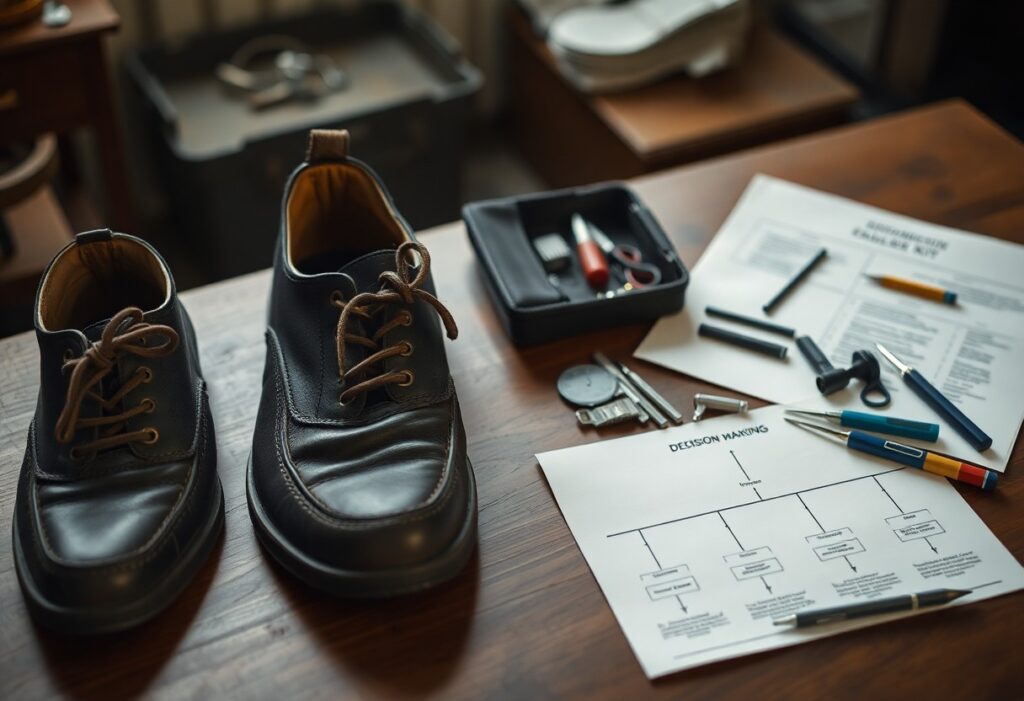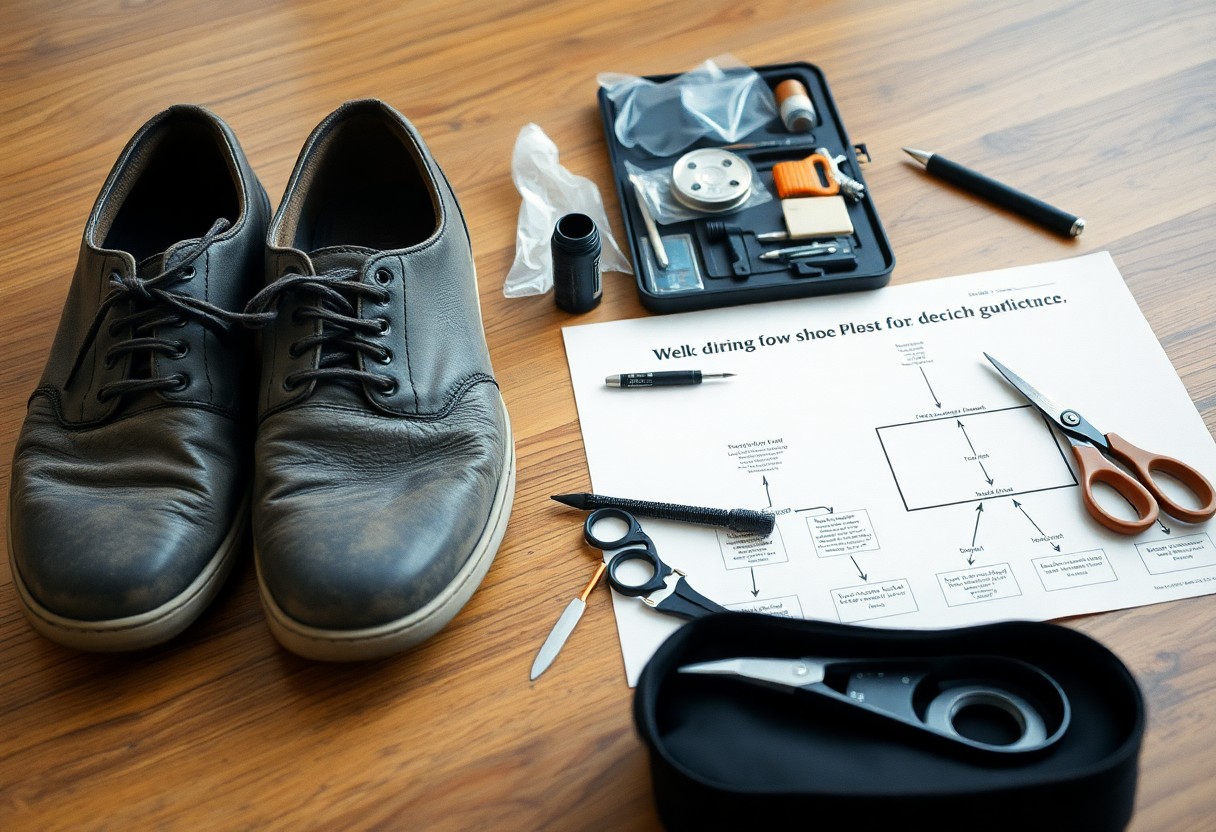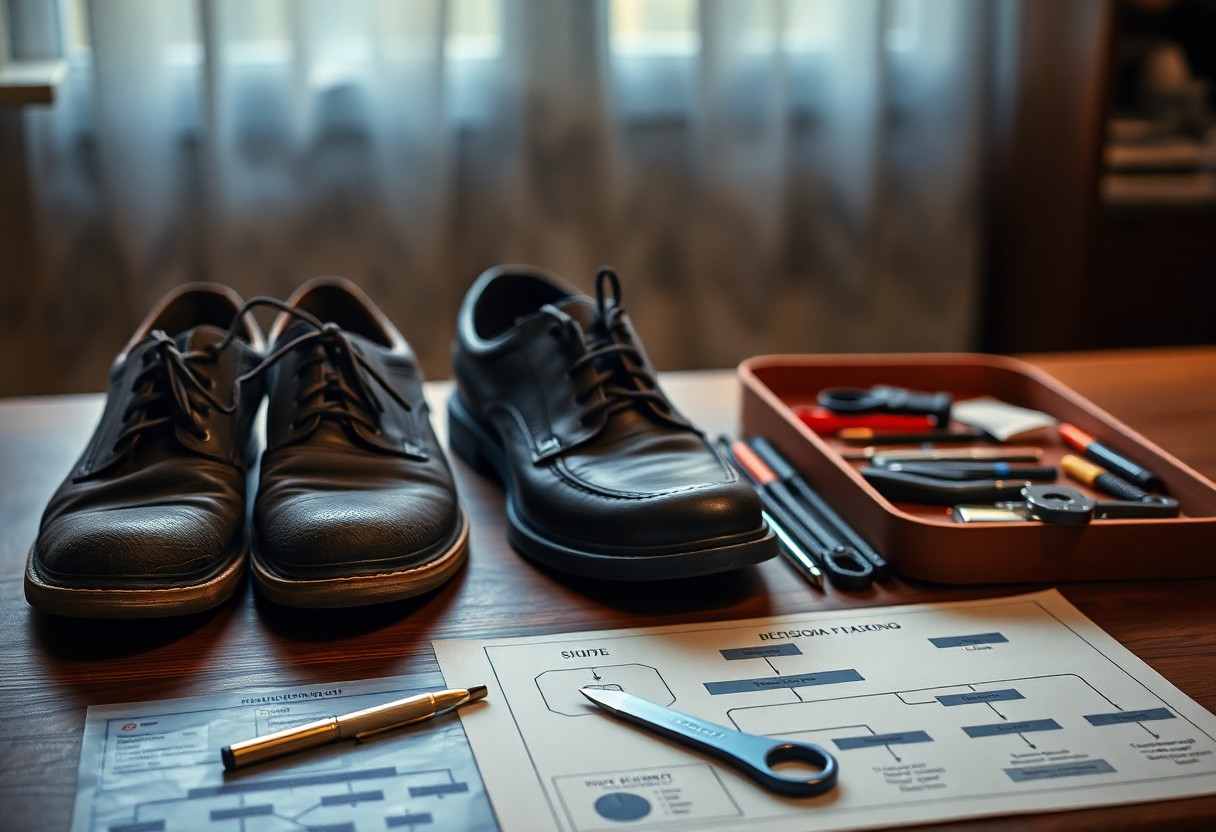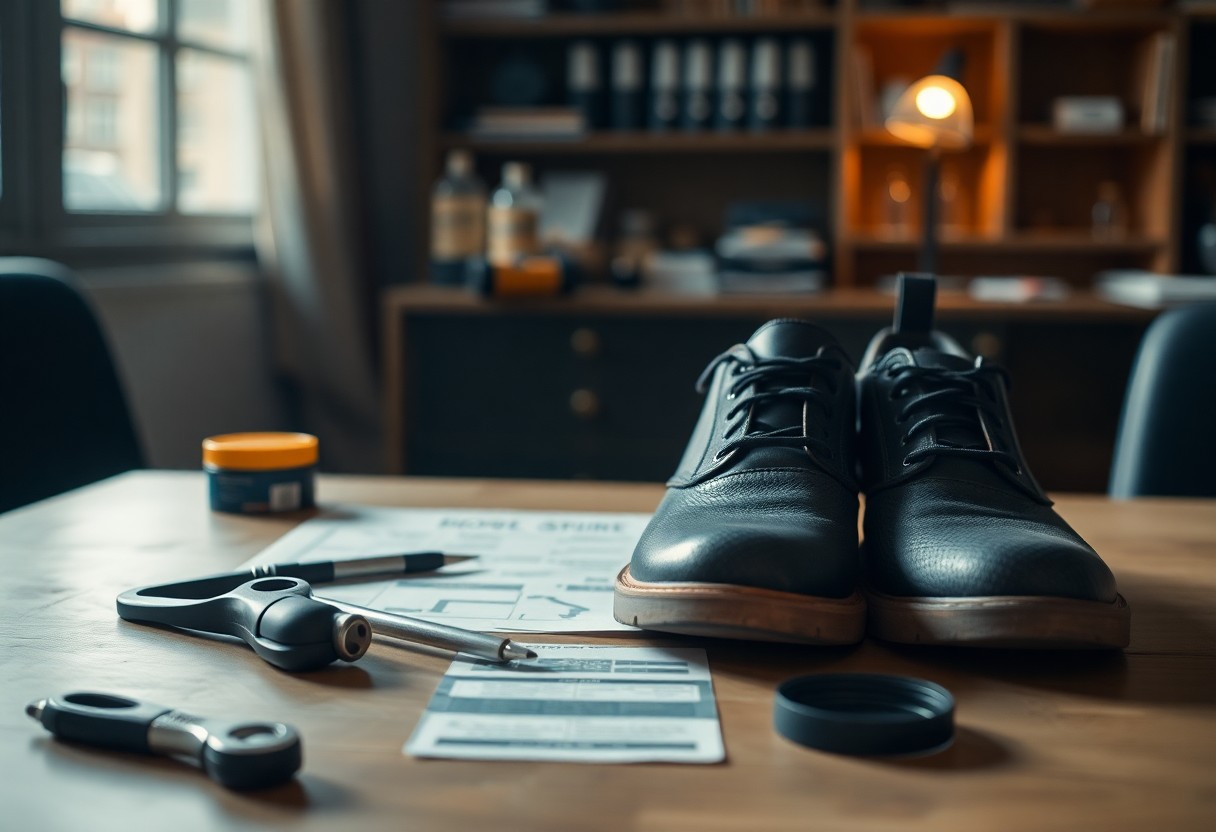
This comprehensive guide is crafted to equip you with the knowledge necessary for making well-informed decisions about your footwear’s future. When confronted with the dilemma of worn-out shoes, deciding between repairing and replacing can have a significant impact on your budget while also prolonging the lifespan of your favorite footwear. Your choice should be influenced by several essential factors, including the original quality of your shoes, the extent of the damage, and the costs associated with repairs. For example, if you own high-quality leather shoes that are suffering from sole wear or heel damage, opting for repairs may be a financially savvy choice. However, if the upper leather is severely damaged or there are multiple structural issues, replacement might be necessary. Grasping these fundamental concepts will enable you to better manage your footwear and make choices that align with your financial goals.

Identify and Understand Common Shoe Damage Types to Make Informed Choices
Before deciding whether to repair or replace your shoes, it is crucial to recognize the common types of damage that can affect your cherished footwear. Shoes can suffer wear in several key areas, including soles, heels, uppers, and structural components. Early identification of these issues can significantly improve your ability to make informed decisions regarding necessary repairs. Understanding the specific damage types will enhance your overall approach to footwear maintenance, allowing you to save both time and money on repairs or replacements.
| Damage Type | Repair Possibility |
| Sole Wear | Usually repairable |
| Heel Damage | Highly repairable |
| Upper Leather Cracks | Limited repair options |
| Structural Issues | Case-dependent |
| Cosmetic Damage | Mostly repairable |
Addressing Common Sole and Heel Issues for Enhanced Longevity
Shoe soles often exhibit the first signs of wear, with heel deterioration being one of the most common problems faced by footwear. It is crucial to pay immediate attention to your shoes if you notice uneven wear patterns or worn edges on the heels. Promptly addressing these issues not only prevents further damage but also improves the overall comfort of your shoes. Regular maintenance can significantly enhance the longevity of your footwear, allowing you to enjoy your favorite pairs for many more seasons.
Recognizing Upper Leather Problems and Their Long-Term Effects
If you own leather shoes, it is common to encounter various issues such as creasing, cracking, and scratches. These problems often stem from daily use and insufficient care. It is essential to realize that the severity of leather damage can vary widely. Some shoes may display merely surface scratches that can be relatively easy to remedy, while others may feature deeper cracks that complicate the repair process. Regularly inspecting your leather footwear can help you catch these problems early, allowing for timely and cost-effective solutions.
Understanding the Implications of Structural Damage for Safety and Comfort
Common structural issues found in shoes include separated soles, broken shanks, and damaged welts. The structural integrity of your shoes directly affects both their comfort and safety. Repairs to these critical elements typically require professional expertise. A skilled cobbler can assess whether the damage is repairable or if a replacement is the more prudent choice. Understanding the structural condition of your shoes can significantly influence your long-term footwear satisfaction and safety.
Dealing with Cosmetic Damage to Restore Your Shoes’ Appearance
Surface scuffs, fading color, and minor scratches fall under the category of cosmetic damage. Fortunately, your shoes can often be revitalized with proper care and treatment. Cosmetic repairs are typically among the most cost-effective options available to footwear owners. With professional cleaning and refinishing services, you can restore your shoes to a nearly new condition, enhancing their overall aesthetic appeal and maintaining your personal style.

Key Factors to Evaluate Before Making Repair or Replacement Decisions
Before you decide whether to repair or replace your shoes, it is vital to evaluate several critical factors. These include the age and condition of the shoes, a careful comparison of repair costs versus the price of new shoes, the quality of materials, and any personal attachment you may have to the footwear. Every decision should integrate practical components with economic implications, ensuring that you are making the best choice for your situation.
- Overall condition assessment
- Cost comparison
- Material quality check
- Sentimental value evaluation
Assessing the Age and Overall Condition of Your Footwear
If your shoes are relatively new, say less than two years old, and exhibit minimal wear aside from sole or heel damage, repairs often represent a worthwhile option. Examine the upper materials for signs of cracks, assess the condition of the insoles, and scrutinize the integrity of the stitching to ensure your footwear remains in good shape. A thorough evaluation of your shoes can help you identify potential repair needs before they escalate, saving you time and money in the long run.
Comparing Costs: Weighing Repairing Against Buying New Shoes
| Basic Repairs | €15-60 |
| Major Repairs | €70-200 |
| New Quality Shoes | €200-500 |
As a general guideline, repair costs should not exceed 50% of the price of new shoes for the decision to be economically viable. This benchmark serves as a crucial reference point when weighing your options, helping you to make a financially sound choice that aligns with your budget.
| Heel Replacement | €15-30 |
| Half Sole Repair | €70-120 |
| Full Sole Repair | €130-200 |
| Heel Lining | €25-60 |
Evaluating Shoe Quality and Material Durability for Informed Decisions
The type of construction and the quality of materials used in your shoes are critical factors to consider during your decision-making process. Welted shoes made from full-grain leather tend to be more amenable to repairs compared to cemented shoes crafted from synthetic materials. The overall repairability of a shoe is often directly correlated to its construction method. Understanding the differences in shoe construction can greatly influence your long-term investment in footwear.
High-quality welted shoes can endure multiple repairs over their lifespan, while less expensive cemented constructions might not justify the effort and cost of fixing. Knowing the materials and construction will guide you in making better choices, ensuring that your footwear investment lasts as long as possible.
Considering Sentimental Value in Your Decision-Making Process
Even shoes that have seen better days may be worth repairing if they hold special significance or are rare vintage finds that evoke fond memories. The comfort level, perfect fit, and emotional attachment to the footwear can justify higher repair costs. As you weigh the practical aspects of your decision, do not overlook these personal values that may influence your choice, helping you to balance sentiment with practicality.
Recognizing Optimal Moments to Repair Your Shoes for Longevity
Your choice to repair shoes should be based on their overall condition and intrinsic value. If your footwear features quality leather uppers and has solid construction, repairs can substantially extend their functional life. Consider undertaking repairs when damage is localized to specific areas, such as the soles or heels, while the overall structural integrity remains intact. This approach allows you to maximize the usefulness of your footwear while minimizing costs.
Identifying Repairable Conditions in Footwear for Cost-Effective Solutions
There are various fixable issues that indicate your shoes are worth repairing, such as worn soles, damaged heels, loose stitching, and minor leather scuffs. Your shoes are good candidates for repair if the upper leather remains intact and the insole shows no signs of cracking. Basic repair costs typically range from $15-60, making them a financially sensible option that can extend the life of your beloved footwear considerably.
Understanding Cost-Effective Repair Scenarios for Wise Decisions
The best time to repair your shoes is when the cost of repair is less than 50% of the price of new shoes. High-quality leather shoes, especially those with welted constructions, are generally worth the investment in repairs, particularly when basic resoling ($70-120) is significantly less than purchasing new high-quality footwear. Cost-effective repairs should be considered when damage is limited to easily replaceable components, ensuring your shoes remain functional while saving you money.
Anticipating the Benefits of Professional Repairs for Enhanced Functionality
With properly executed repairs, you can expect restored functionality and a significantly extended lifespan for your footwear. Well-repaired shoes can offer several additional years of wear, especially with quality resoling or heel replacement work. The expected longevity of repairs varies depending on the type performed: heel replacements may last anywhere from 6 months to 2 years, while resoled shoes can provide an additional 2-5 years of service with proper care. A successful repair ensures your shoes remain comfortable and stable, maintaining their original fit and support.
Recognizing When It’s Necessary to Invest in New Shoes
It becomes essential to replace your footwear when the costs of repairs exceed 50% of the price of new shoes, or when structural damage renders repairs impractical. Warning signs include severe cracks in the upper leather, compromised insoles, or multiple repair needs arising simultaneously. Identifying these conditions early can save you from investing in repairs that won’t yield satisfactory results.
Identifying Situations Where Repair is Not a Viable Option
Certain types of damage are beyond repair, and it’s vital to recognize these limitations. Watch for deep cracks in multiple areas of the upper leather, severely damaged insoles, or widespread structural failures. When you notice these issues, it is prudent to start shopping for replacements instead. Understanding the boundaries of repairable damage can help you make more informed choices about your footwear.
Analyzing Economic Considerations for Repair Versus Replacement
Not all repairs are created equal from a financial standpoint. Basic repairs such as heel replacements (€15-30) and sole repairs (€70-120) can be economical choices for maintaining quality shoes. However, if multiple repairs are needed simultaneously, it may indicate that it’s time to consider new shoes. Given that quality welted shoes typically range from €200-500, comparing repair costs to the original price is crucial. If the total repair costs surpass half the price of new shoes, then purchasing new footwear becomes the more sensible financial choice.
Prioritizing Safety Concerns When Assessing Footwear for Risk Management
Worn-out shoes can pose a serious risk of foot injuries and accidents. Signs such as completely smooth soles, exposed steel toe caps, or compromised water resistance indicate that your shoes are no longer providing adequate protection. Safety considerations should include your working environment; if you work in hazardous conditions or require specific safety features, even minor structural damage can render your shoes unsafe for use. It is essential not to compromise your safety by wearing damaged footwear, as the risks can have serious consequences.

Your Systematic Step-by-Step Assessment Guide for Footwear Decisions
To keep your shoe evaluation organized and efficient, follow this systematic approach to determine whether to repair or replace your shoes. By using a structured method, you can make informed decisions that will benefit your footwear investment.
| Repair Indicators | Replacement Indicators |
| Worn soles (no welt damage) | Cracked insoles |
| Heel wear (surface only) | Multiple upper cracks |
| Minor scratches | Severe structural damage |
Thorough Damage Evaluation Process for Informed Decision-Making
The first step in assessing your shoes is to examine them in <a href="https://limitsofstrategy.com/interior-lighting-options-for-your-home/">adequate lighting</a>. Look closely at the soles, heels, upper leather, and insoles for any signs of wear. A half sole replacement typically costs between €70-120, while a full sole repair can range from €130-200. This knowledge will help you budget effectively for necessary repairs.
- Sole integrity check
- Upper leather inspection
- Heel stability assessment
- Insole condition evaluation
Maximizing Professional Consultation for Optimal Outcomes in Footwear Maintenance
Seeking damage assessment from a qualified professional can significantly enhance your ability to make an informed decision regarding your shoes’ future. Here are essential tips to keep in mind:
- Obtain multiple opinions if necessary
- Inquire about repair costs upfront
- Request timeline estimates for the repair process
- Compare repair estimates with new shoe prices
When visiting a cobbler, it is advisable to bring both shoes for a thorough assessment. Document any specific issues you’ve encountered and inquire about warranty coverage for the proposed repairs. Understanding that a professional evaluation typically costs between €15-30 can aid in budgeting for this essential service.
Exploring Professional Repair Options for Your Footwear for Longevity
To prolong the life of your shoes, utilizing professional repair services can provide specialized solutions for various shoe-related issues. Local cobblers are equipped to handle everything from basic resoling to complex leather repairs, often at a fraction—30-50%—of the cost of purchasing new shoes. The decision to repair ultimately hinges on the shoe’s quality and the extent of the damage, ensuring you make the most cost-effective choice.
Discovering the Various Types of Shoe Repair Services Available to Suit Your Needs
| Service | Average Cost |
|---|---|
| Heel Replacement | $15-30 |
| Full Sole Replacement | $50-70 |
| Leather Patching | $20-40 |
| Stitching Repair | $10-25 |
| Stretching | $15-20 |
- Resoling – Complete sole replacement
- Heel repair – Replacing worn heel tips
- Leather work – Patching and restoration
- Stretching – Adjusting shoes for size
Finding a Qualified Cobbler for Your Repair Needs to Ensure Quality Work
When searching for a reliable shoe repair professional, prioritize certified cobblers with positive customer reviews and a minimum of five years of experience. The best options typically include shoe repair shops equipped with specialized tools and a proven track record in handling your specific type of footwear. Ensuring that you choose a qualified professional will lead to higher satisfaction with the repair process.
For instance, you can verify a cobbler’s credentials by checking their certification from the Shoe Service Institute of America, assessing the cleanliness of their workshop, and asking to see examples of their previous repair work. Many local shoe stores maintain partnerships with trusted repair professionals and can provide reliable recommendations based on your specific needs.
Making Informed Choices for Your Footwear Needs and Financial Well-Being
With the information provided, you now possess the knowledge to make better decisions regarding whether to repair or replace your shoes. Generally, shoes are more likely to be repairable when the damage is limited to the soles, heels, buckles, or surface scratches. Conversely, consider investing in new footwear when you observe cracks in the upper leather or insole, as these repairs often incur higher costs than replacements and seldom yield satisfactory results. The key lies in maintaining your shoes appropriately and addressing repairs promptly. By carefully weighing repair costs against the shoe’s overall value and condition, you can significantly extend the life of your footwear while also saving money over time.
Frequently Asked Questions (FAQ) About Shoe Repair and Replacement
Q: How can I determine if my shoes are worth repairing or if I should buy new ones?
A: Evaluate the following key factors: If your shoes feature high-quality leather uppers without cracks and only require repairs to the soles or heels, then repairs are advisable. The total repair cost should be less than 50% of the price of new shoes. Basic repairs such as heel replacements ($20-35) and resoling ($70-120) are typically sensible for quality shoes. If the upper leather shows cracks, the insole is damaged, or repairs exceed half the price of new footwear, consider purchasing new shoes for a better investment.
Q: Which shoe repairs provide the best value for the cost?
A: The most cost-effective repairs include heel replacements ($20-35), heel lining repairs ($25-60), and simple regluing of separated parts ($10-20). These repairs can significantly extend the lifespan of your shoes at a minimal expense. Half-sole replacements ($70-120) also present good value for quality welted shoes. It’s crucial not to delay necessary repairs, as this can lead to more expensive damage that may ultimately require complete shoe replacement.
Q: What types of shoe damage are generally irreparable?
A: There are three primary types of damage that make repairs impractical: 1. Deep cracks in the upper leather, particularly in creasing areas 2. Structural cracks in the insole 3. Multiple significant damages that would require repair costs exceeding the price of new shoes. These issues compromise the fundamental structure of the shoe, and repairs often yield unsatisfactory results. In such cases, purchasing new shoes is typically the better alternative.
The Article Guide on deciding when to repair shoes versus buying new practical tips for making the right choice appeared first on My Shoes Finder
The Article Deciding to Repair Shoes or Buy New: Essential Tips Was Found On https://limitsofstrategy.com


Ah, the age-old footwear dilemma—repair or replace? It feels a bit like deciding whether to keep that favorite pair of pants that has seen better days or to bite the bullet and admit they’re just too far gone. A philosopher once contemplated whether a shoe is still the same shoe after it’s been resoled three times. We’re really just asking the deeper questions of life here, right?
You’ve touched on something really profound with your mention of the philosopher and that age-old question about identity. It’s intriguing to me how we place value not just on objects, but also on the stories they carry. A worn-out pair of shoes or those favorite pants doesn’t just represent fabric or leather; they embody memories, experiences, and pieces of our personalities.
You’re tapping into something really profound with that footwear dilemma. It’s funny how a pair of shoes or a well-worn piece of clothing can serve as a metaphor for so much in life. When I think about the philosopher’s question—whether a shoe remains the same after multiple resoles—I can’t help but draw parallels to our own experiences. Each time we face challenges, adapt, or even just change our perspectives, aren’t we, in a sense, reshaping our own identity?
You hit the nail on the head with that comparison. It’s funny how footwear choices can feel so deeply personal, like deciding whether to keep that old pair of pants. There’s something comforting about sticking with familiar, worn-in stuff, right?
You’ve captured that dilemma perfectly. It really is a reflection of our relationships with objects, isn’t it? This idea of “repair or replace” stretches beyond footwear and clothing; it touches on everything from old cars to even friendships. I think about my own worn-out sneakers that have cradled my feet through countless adventures. Each scuff and fray tells a story, and part of me feels like those shoes are a piece of my history—a bit like that favorite pair of pants you mentioned.
What a fantastic dive into the complex world of shoe care! It’s funny how our footwear often has its own dramatic life story, isn’t it? I mean, every pair of shoes has its triumphs and tribulations—much like us humans. I once had a favorite pair of sneakers that felt like they could run a marathon with me. But then one day, as I was joyfully springing down the street, I heard an awful squelching sound. It was like my shoes were trying to communicate with me: “Please, just let us retire gracefully!”
Your guide touches on a dilemma that many of us face — balancing our love for our favorite shoes with the practicalities of wear and tear. I recently found myself in a similar situation; I had a pair of sturdy hiking boots that had seen countless adventures. Initially, I was tempted to replace them due to some noticeable scuffs and a worn-out sole. However, after getting them repaired, they felt like a new pair, and I saved quite a bit!